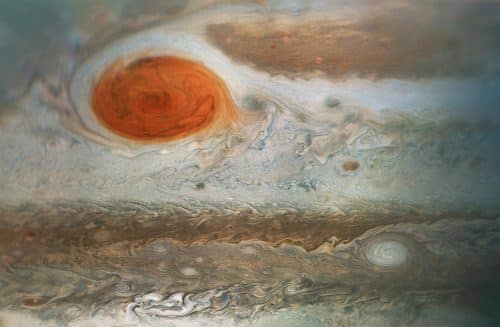Data collected from meteorites showed that at the beginning of the solar system two separate regions were formed for about 2 million years. According to researchers from Switzerland, the one to blame for this is the planet Jupiter, which in those two million years slowly grew from 20 to 50 Earth masses

With a diameter of approximately 143 km, Jupiter is the largest planet in the solar system, with a mass approximately 300 times that of Earth. The formation mechanism of giant planets like Jupiter has been a hotly debated topic for several decades. Now planetary researchers at the Swiss National Research Center and the universities of Bern, Zurich and ETH Zürich have discovered some of the processes that took place on Jupiter during its formation plus new measurements.
"We were able to show that Jupiter grows in different and distinct stages," explains Julia Ventorini, a postdoctoral fellow at the University of Zurich. Ventorini and the paper's lead author Jan Albert, PlanetS's chief science officer, decided to form a research team after hearing at a scientific conference about evidence in meteorite compositions of what happened in the early solar system. The team included researchers from three universities and experts in various fields such as astrophysics, cosmochemistry and hydrodynamics. The group met in Bern under the framework of NCCR which enables a connection between scientists from different fields.
"Initially, the passing planet from which Jupiter evolved hurriedly attached and glued small pebbles of a centimeter size into it, and this is how the core of the planet was quickly built during the first million years. The next two million years were characterized by larger, lower-density rocks. They hit the planet and released heat. "
During the planetary embryo stage, it quickly attached small centimeter-sized pebbles, rapidly building a core during the first million years. The next two million years were dominated by planetary (or pre-planetary), mile-sized rocks. They hit the growing planet with high intensity and released heat. "In the first step, the pebbles brought the mass," says Albert. "In the second stage, the planetaryists also added a little mass, but more importantly, they brought energy." After three million years, Jupiter grew into a body with a mass of fifty Earths, and in the third stage the gas began to accumulate that turned Jupiter into today's gas giant, with a mass of over 300 Earth masses.
The new model for the birth of Jupiter is consistent with the meteorite data presented at a conference held in the USA last year. Measurements of the composition of the meteorites showed that in the early periods of the solar system, the nebula from which the planets were formed was divided into two regions for two million years. Therefore it can be concluded that Jupiter served as a kind of obstacle when it grew from 20 to fifty Earth masses. During this period the nascent planet disturbed the dust disk, creating an excess density as it captured the pebbles that fell into its orbit. Therefore, the material from the outer regions could not mix with that of the inner materials until Jupiter had enough mass and then stopped growing, thus allowing the scattering of rocks from the outer solar system into the interior.
"Why did Jupiter take two million years to grow from 20 to fifty Earth masses? Ventorini asked. "It seems like too long," she explains. "This was the question that motivated our research."
An explanation of the late growth
The researchers' calculations showed that the time the young planet spent in the mass range of 50-15 Earth masses was indeed longer than previously felt. At this stage of formation, collisions with kilometer-sized rocks provided enough energy to heat Jupiter's gas atmosphere and prevented rapid cooling, contraction, and further consumption of gas from space. "The pebbles were important in the first stage to build a core quickly but the heat provided by the large rocks delayed the accumulation of gas. This corresponds to the timetable provided by the meteorites." The two conclude. They are convinced that their findings will also help to examine how the other gaseous planets were formed - especially Uranus-Uran and Neptune-Rahab.
More of the topic in Hayadan:
